Disclosure: Meeple Mountain received a free copy of this product in exchange for an honest, unbiased review. This review is not intended to be an endorsement.
Jack Nicholson’s Joker once asked of Batman, “Where does he get those wonderful toys?” It’s a question you might well ask of your favorite D&D-style Adventurers in any number of board games.
In Bargain Quest the answer is simple: from you!
Players in Bargain Quest take on the role of shopkeepers, each trying to sell the most expensive items to Adventurers eager to spend money to arm themselves before doing battle against an end-round Monster. Players collect points for the money they earn and from the damage the Adventurers they have equipped do to that round’s Monster. Have the most points after the third Monster is defeated and you win the game.
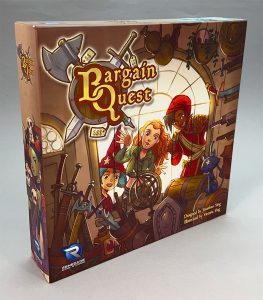
How to Play
Setup
Players start by selecting one of the many colored shopkeeper boards and placing it in front of them. Despite being different colors, the boards are all identical in their layouts and abilities.
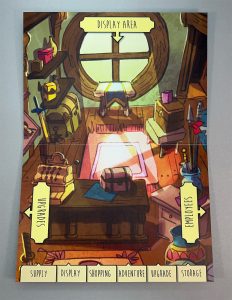
Shuffle each of the decks of cards (Items, Heroes, Employees) and set them within reach of all of the players. Shuffle the Monster cards according to the number on the back (1, 2, and 3) and choose one Monster from each tier and set them in a stack, with the tier 1 card on top and tier 3 on the bottom, face down. Return all other Monster cards to the box.
Set aside the Upgrade cards. Shuffle the small Adventure cards and place them face down. Place the coin tokens within easy reach of all players, or choose a banker to be in charge of the money.
Give each player five coins from the bank. Choose one player and give them the Quest Token.
Draw a number of heroes from the Hero deck equal to the number of players and place them face up within view of all players. Place coins on each Hero card equal to the number in the purse icon in the upper right corner of the card.
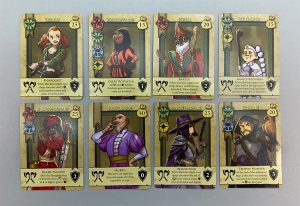
Start by turning the top Monster face up so all players can see what kind of Monster the Adventurers will be facing, paying close attention to the Monster’s attack and defense numbers. Adventurers must do better than these numbers to inflict damage and/or survive into the next round of play.
The Cards
Then deal four Item cards to each player. Each player will choose one card, then pass the remainder to their left. Cards are drafted this way until all players end up with four cards.
Item cards and Adventurer cards each have a series of thematic class icons to determine which type of Adventurer you can sell which type of items to. The fiery red icon is for Mages, the blue helmet and swords is for Fighters, the tan star is for Clerics, and the green mask and arrows is for Rogues. Thankfully, there are several cross-class Adventurers (Bards as Mage and Rogue, Paladins as Fighter and Cleric), meaning you’ll be able to sell Items with either icon to that Adventurer.
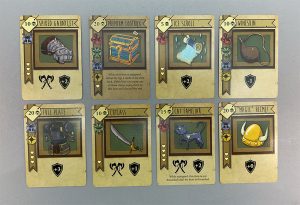
This is because you can’t just choose an Adventurer to sell your items to. No no no. Remember, you and your opponents are all shopkeepers. And as a shopkeeper, you’ll need to put something intriguing and flashy in your window display to attract the right type of Adventurer to your shop.
This is where you have to balance the icons on cards in your hand with the Adventurer class icons. You’ll need to have one card with the class icon of an Adventurer in play to put in your shop window and at least one other card with the same icon to sell. But how do you get that Adventurer to come through your doors with all of their money?
In a clever blind bidding mechanic, each Item card also has a series of hearts that run down the left side. When selecting your window display card, you’ll need to weigh how much money your Adventurer class-matching item(s) will bring in versus the number of hearts on another card with the same class icon.
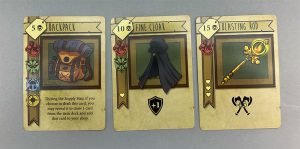
Window display cards are placed face down in the Display Area of your player board. When all players are ready, these cards are turned face up and the player whose Item card has the most hearts gets first choice of Adventurer.
Equipping Those Adventurers
Each player places their chosen Adventurer card (and the accompanying money) beside them. Having successfully lured an Adventurer into their shop, players may now sell any of the cards with matching class icons still in their hand to the Adventurer. Alas, that flashy card you put on display cannot be sold in that round. Those are For Display Purposes Only.
Some Adventurer’s cards include flavor text with purchasing bonuses or effects. Follow those special rules while selling items.
After shopkeepers have all sold as many class-matching Item cards as their Adventurer has money to buy, it’s time to get ready to battle the round-end’s Monster.
End Round Fighting
Each player starts by taking a look at their Adventurer’s fighting and defense stats in the lower left and right corners of their Adventurer’s card. Then, check the flavor text to see if there are any combat bonuses or effects.
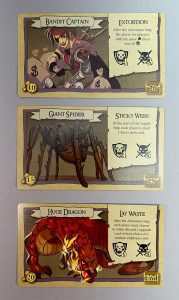
Then, just before entering into the fray, each Adventurer is dealt a small Adventure card. Think of this as something of a Dexterity check. Adventure cards range from Unlucky (-1 attack, -1 defense) to Awesome (+2 attack, +2 defense).
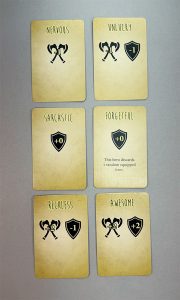
With these modifiers applied to the Adventurer’s stats, the attack on the Monster can begin. Starting with the player who holds the Quest Token, Adventurers’ stats are compared with those of the current end-round Monster.
If your Adventurer’s attack is greater to or equal to the Monster’s toughness, the Monster is wounded and receives a wound token. As a reward, you gain a Star token, worth one point at the end of the game. Then check the Monster’s strength. If your Adventurer’s defense is equal to or higher than the Monster’s strength, they survive to fight again in the next round and you gain a Star token. If not, they are killed and eliminated from the game.
Each Monster has a total hit point count equal to the number of players. If none of the players manage to successfully attack the Monster, the Monster still receives a hit damage token at the end of the round.
Also, be sure to read the text on the Monster’s card. They usually do something mean and nasty to one or more of the players after being attacked.
If the Monster has not been defeated, each surviving Adventurer receives coins equal to the number in the lower left corner of the Monster’s card. If the Monster is defeated, surviving Adventurers each receive the amount shown in the lower right corner.
Cleanup
Then discard all Item cards purchased by the Adventurers in that round. All surviving Adventurers go back to the common area, ready to go shopping again. Any defeated Adventurers are replaced from the top of the Adventurers deck.
Before starting the next round, you might want to spend some of that money you made from selling your goods to improve your shop—or your chances in the game.
Starting with the player who has the Quest Token, players may purchase an Employee card or an Upgrade card. Employees offer a range of typically one-time benefits, from allowing you to sell your Display card to changing the price of an item, to stealing another player’s Item card. Upgrade cards allow you to either place additional Item cards in your Display (thereby increasing the number of hearts during the bidding phase) or allow you to add more Item cards to your Storage Area.
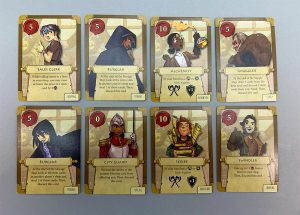
Speaking of your Storage Area, once all players have had a chance to purchase Employees or Upgrades, they discard all of their remaining Item cards except one (unless, of course, they’ve bought a Storage card). This Item card goes into their Storage Area to be used again in the next round.
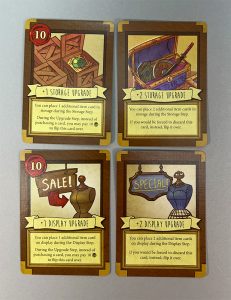
Play continues in this manner until all of the Monsters have been defeated. Players then total up their stars and coins (with 10 coins equalling one point) and the player with the most points wins the game.
Thoughts
Bargain Quest gets a lot of things right. The game is light and engaging enough to be a good family game or gateway game for introducing new people to the hobby. The D&D theme is well-woven into the game, making Bargain Quest feel like a real D&D offshoot. (I’m still looking at you, Lords of Waterdeep.)
The hidden bidding mechanic of the Display Area works well, forcing players to make an important choice at the start of each round that will help determine their fate for that round. Do I put this 4-heart Berserker Axe in the shop window to attract that Fighter? Or do I take a chance with the 2-heart Steel Sword in hopes that I can get 15 coins by selling that same Axe?
It may just be me, but there’s also something amusing about taking all of an eager Adventurer’s money, knowing that said Adventurer is not going to survive their encounter with the Monster. I’m happy to sell a Mage or a Rogue those “Cool” Goggles for 20 coins, despite the fact they don’t do anything to help against the Monster. That wineskin? It’s yours for a mere 10 coins…although you’ll lose -1 defense for imbibing before battle.
The artwork strikes a good balance between thematically D&D and being just cartoon-y enough to not intimidate youngsters. I was very glad to see Adventurers and Employees represented by both sexes and a variety of ethnic groups. That makes Bargain Quest a game I’d happily play with kids.
While I appreciate the standard playing card size of all of the cards (with the odd exception of the Dexterity-check Adventure cards. Why are these so annoyingly small?) I’ve noticed that each of the cards I’ve had face up next to me while I’ve been writing this review have started to curl up at the edges. That’s a bit concerning.
But how do I feel about the game itself?
It’s a lighter card game with elements that have made us laugh more than once each time we’ve played it. The artwork is good and culturally inclusive, and it’s an easy teach. So, what’s not to like?
I’ve given this a lot of thought over the past months. See, Bargain Quest is a game I really want to like. Instead, after each game I’ve felt like I wanted there to be something more to the game than what’s there.
Since this is a card game, there is a large element of luck that comes into play. I’ve played more than one game of Bargain Quest where the class-type of the Adventurers on offer has been limited and, due to the initial drafting mechanism, one person has ended up with nothing that can be sold to any of the Adventurers. This is both frustrating and puts that player at an early disadvantage for points. (It’s also simply not fun.)
The frustration of someone at the table not being able to sell to an Adventurer due to the cards in their hand not matching the class icons on the Adventurer’s card has happened more than once and it’s hard to forgive an otherwise friendly game that punishes a player simply for having a bad luck of the draw. (I think I’ll suggest a House Rule that allows any player in that position to sell one card regardless. Or, increase the number of Adventurers to at least four, insisting that one of each class be out Shopping in each round.)
Also, the end of round battles have always felt a bit anticlimactic to me. Maybe it’s because I’ve played Bargain Quest with the same people I DM for in Dungeons and Dragons, but battling Monsters leaves a lot to be desired. Compare Attack to Toughness, then compare Defense to Strength. Done. That’s it. There’s no real tension here as you’ve already done this in your head long before the battle takes place. And while the (tiny) Adventure cards can alter your totals somewhat, they’re not enough to make up for that lack of suspense.
The fact that despite each Monster’s stats increasing, they’re each still defeated by hits equal to the number of players makes them each a bit too much the same for me as well.
Bargain Quest is a good gateway game, both as an entree into the hobby and to introduce younger players to the world of D&D. It’s a game I’m generally willing to play if someone were to ask—although I might make a few suggestions for other games first.


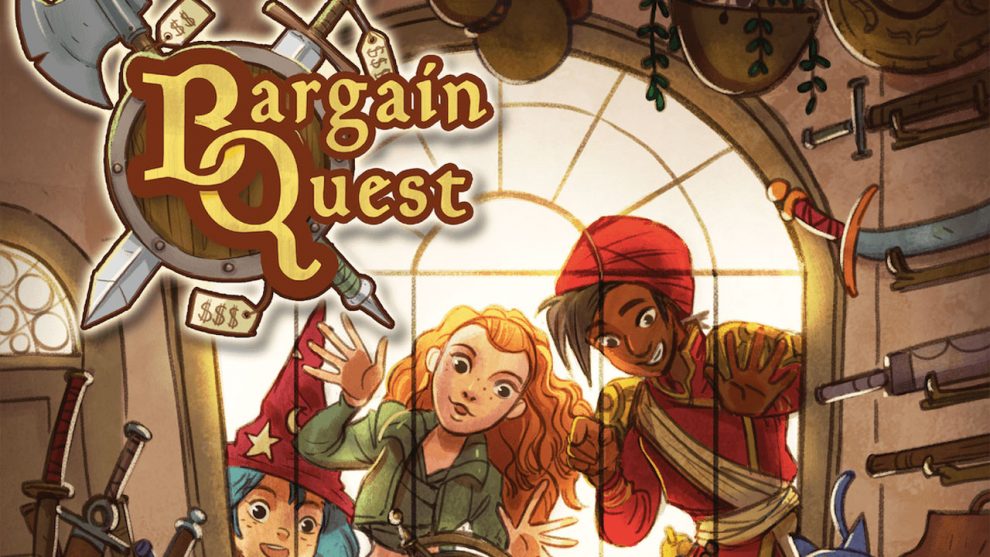


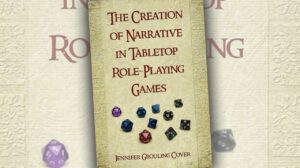
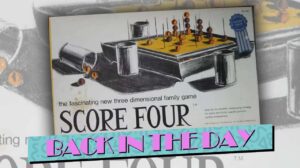





Add Comment